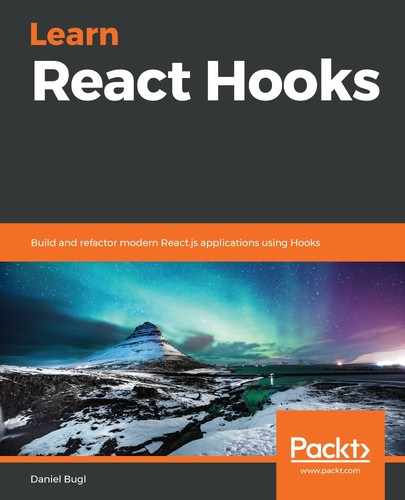In this chapter, we first learned what MobX is, which elements it consists of, and how they work together. Then, we learned how to use MobX for state management in practice. We also learned how to connect a MobX store to React components, by using the inject and observer higher-order components. Next, we replaced the higher-order components with Hooks, which made our code much more clean and concise. We also learned how to use a Local Store Hook to deal with complex local state in MobX. Finally, we learned how to migrate an existing MobX application to Hooks, and we recapped what the trade-offs of using MobX are.
This chapter marks the end of this book. In this book, we started out with a motivation to use Hooks. We learned that there are common problems in React apps that cannot be easily solved without Hooks. Then, we created our first component using Hooks and compared it to a class-component-based solution. Next, we learned about various Hooks in depth, starting with the State Hook, which is the most ubiquitous of them all. We also learned about solving common problems with Hooks, such as conditional Hooks and Hooks in loops.
After learning about the State Hook in depth, we developed a small blog app using Hooks. We then learned about Reducer Hooks, Effect Hooks, and Context Hooks, in order to be able to implement more features in our app. Next, we learned how to request resources efficiently using Hooks. Furthermore, we learned how to prevent unnecessary re-rendering with React.memo, and how to implement lazy-loading with React Suspense. Then, we implemented routes in our blog app, and we learned how Hooks can make dynamic routing much easier.
We also learned about various Hooks that are provided by the community, which make dealing with input fields, various data structures, responsive design, and undo/redo functionality so much easier. Furthermore, we learned about the rules of Hooks, how to create our own custom Hooks, and how interactions between Hooks work. Toward the end, we learned how to effectively migrate from existing class-component-based apps, to a Hook-based solution. Finally, we learned how to use Hooks with Redux and MobX, and how to migrate existing Redux and MobX applications to Hooks.
Now that we have learned about Hooks in depth, we are ready to use them in our applications! We have also learned how to migrate existing projects to Hooks, so we can start doing that now. I hope you enjoyed learning about React Hooks, and that you are looking forward to implementing Hooks in your applications! I am sure that using Hooks will make coding much more enjoyable for you, just like they did for me.
